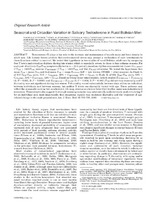Mostrar el registro sencillo del ítem
Seasonal and circadian variation in salivary testosterone in rural Bolivian men
| dc.contributor.author | Vitzthum, Virginia J | |
| dc.contributor.author | Worthman, Carol M | |
| dc.contributor.author | Beall, Cynthia M | |
| dc.contributor.author | Thornburg, Jonathan | |
| dc.contributor.author | Vargas, Enrique | |
| dc.contributor.author | Villena, Mercedes | |
| dc.contributor.author | Soria Sánchez, Rudy | |
| dc.contributor.author | Cáceres, Esperanza | |
| dc.contributor.author | Spielvogel, Hilde | |
| dc.date.accessioned | 2016-10-04T16:14:48Z | |
| dc.date.available | 2016-10-04T16:14:48Z | |
| dc.date.issued | 2009-02-19 | |
| dc.identifier.uri | http://repositorio.umsa.bo/xmlui/handle/123456789/8155 | |
| dc.description.abstract | Abstract. Testosterone (T) plays a key role in the increase and maintenance of muscle mass and bone density in adult men. Life history theory predicts that environmental stress may prompt a reallocation of such investments to those functions critical to survival. We tested this hypothesis in two studies of rural Bolivian adult men by comparing free T levels and circadian rhythms during late winter, which is especially severe, to those in less arduous seasons. For each pair of salivary TAM/TPM samples (collected in a 12-h period), circadian rhythm was considered classic (CCLASSIC) if TAM > 110%TPM, reverse (CREVERSE) if TPM > 110%TAM, and flat (CFLAT) otherwise. We tested the hypotheses that mean TAM > mean TPM and that mean TLW < mean TOTHER (LW 5 late winter, OTHER 5 other seasons). In Study A, of 115 TPM–TAM pairs, 51% 5 CCLASSIC, 39% 5 CREVERSE, 10% 5 CFLAT; in Study B, of 184 TAM–TPM pairs, 55% 5 CCLASSIC, 33% 5 CREVERSE, 12% 5 CFLAT. Based on fitting linear mixed models, in both studies TOTHER-AM > TOTHER-PM (A: P 5 0.035, B: P 5 0.0005) and TOTHER-AM > TLW-AM (A: P 5 0.054, B: P 5 0.007); TPM did not vary seasonally, and T diurnality was not significant during late winter. T diurnality varied substantially between days within an individual, between individuals and between seasons, but neither T levels nor diurnality varied with age. These patterns may reflect the seasonally varying but unscheduled, life-long, strenuous physical labor that typifies many non-industrialized economies. These results also suggest that single morning samples may substantially underestimate peak circulating T for an individual and, most importantly, that exogenous signals may moderate diurnality and the trajectory of agerelated change in the male gonadal axis. | es_ES |
| dc.language.iso | en | es_ES |
| dc.publisher | American Journal of Human Biology | es_ES |
| dc.subject | VARIACIONES EN TESTOSTERONA SALIVAL | es_ES |
| dc.subject | HOMBRES RURALES DE BOLIVIA | es_ES |
| dc.title | Seasonal and circadian variation in salivary testosterone in rural Bolivian men | es_ES |
| dc.type | Article | es_ES |

